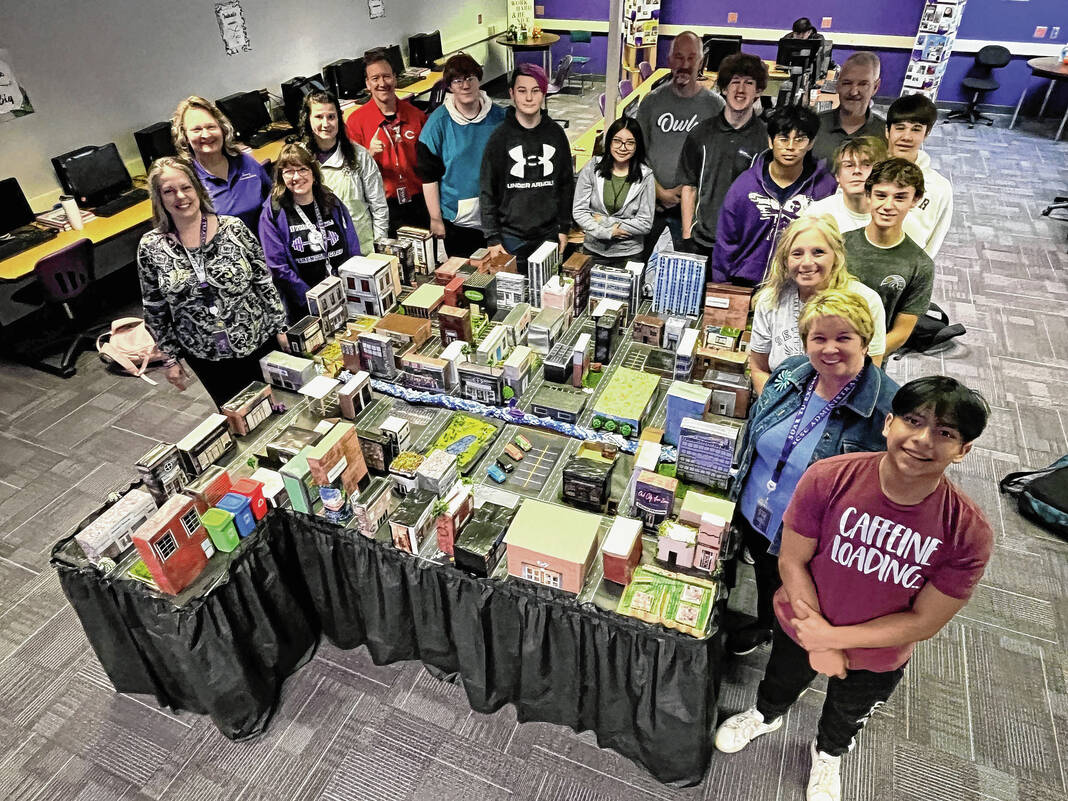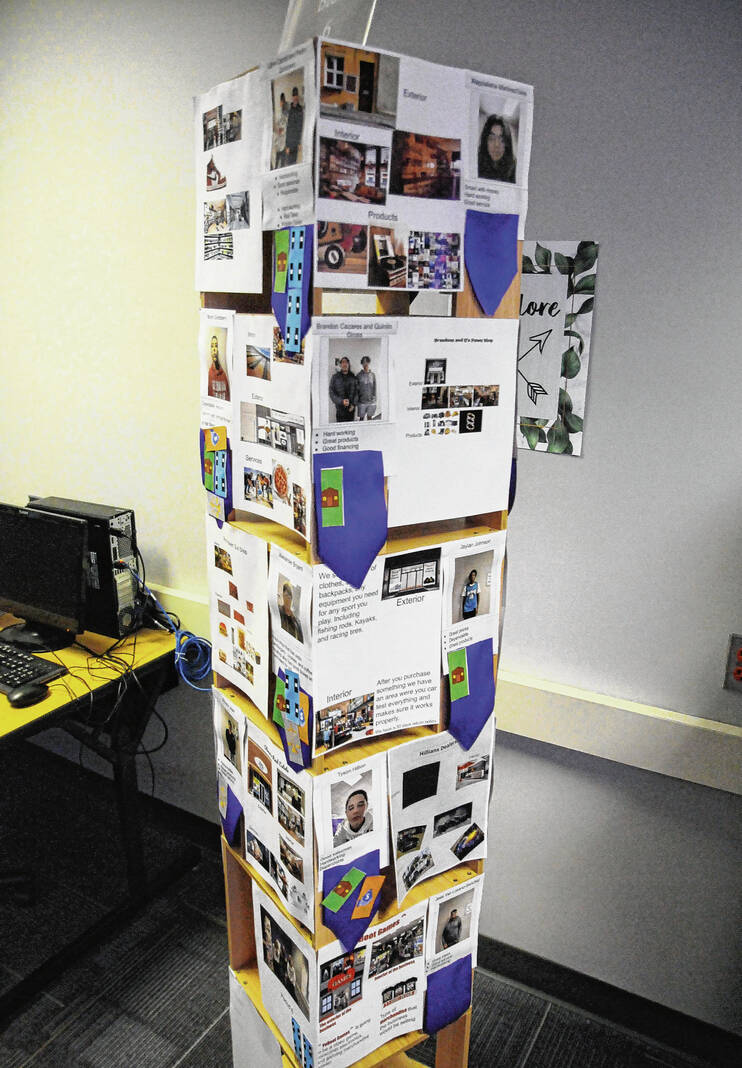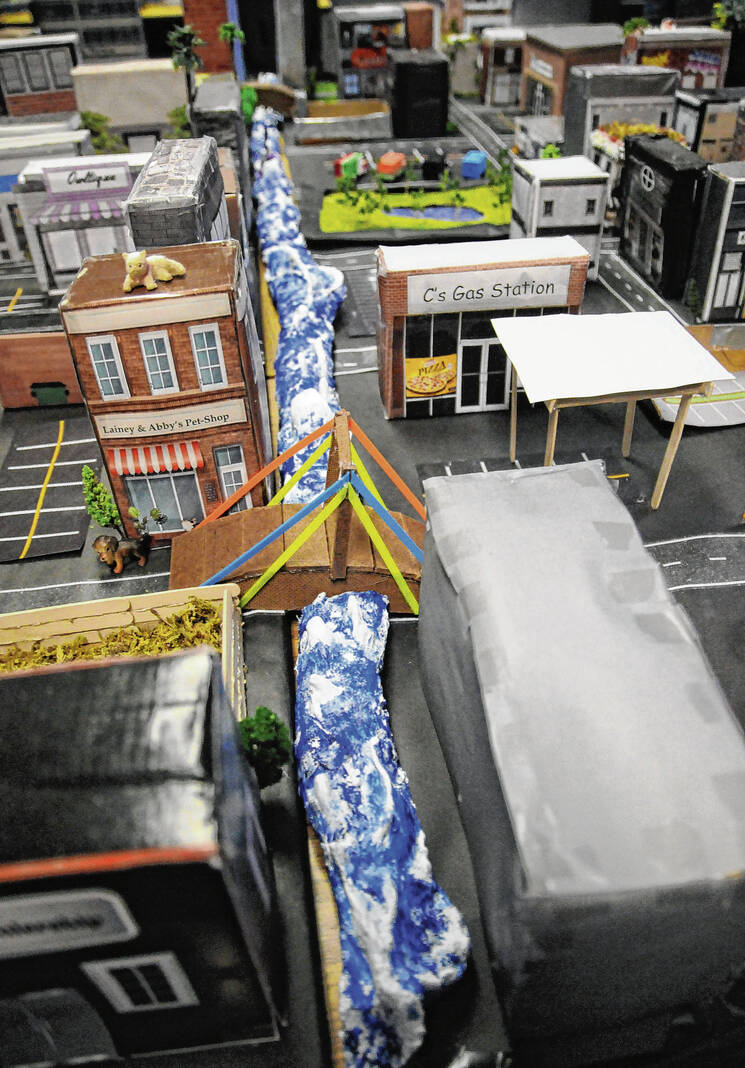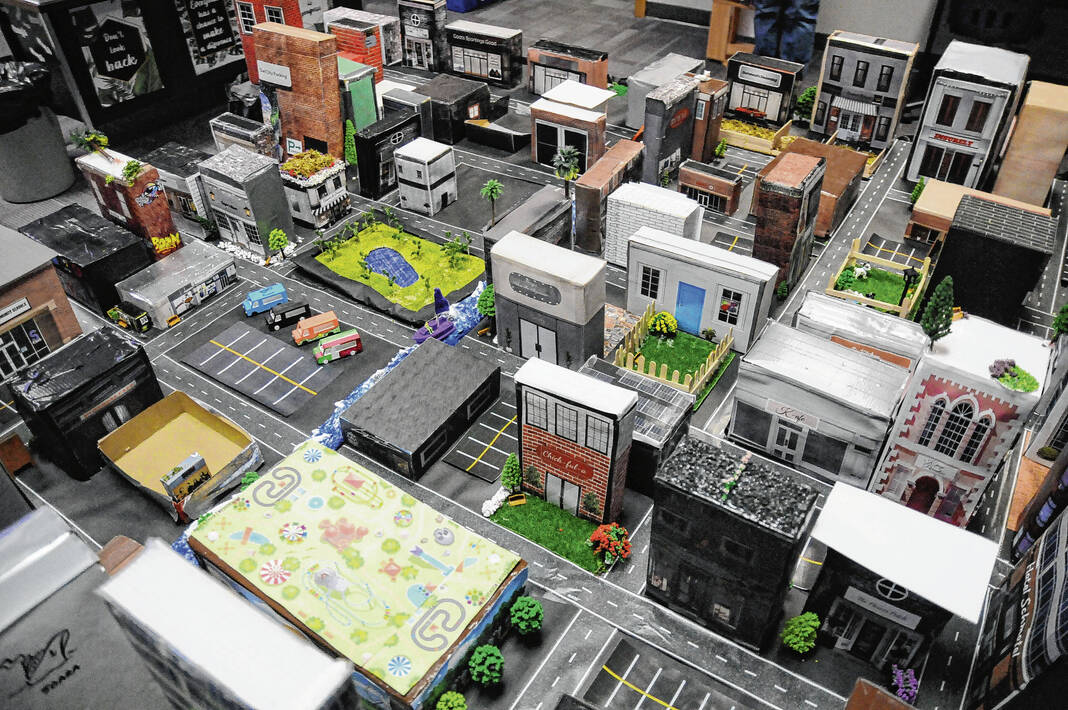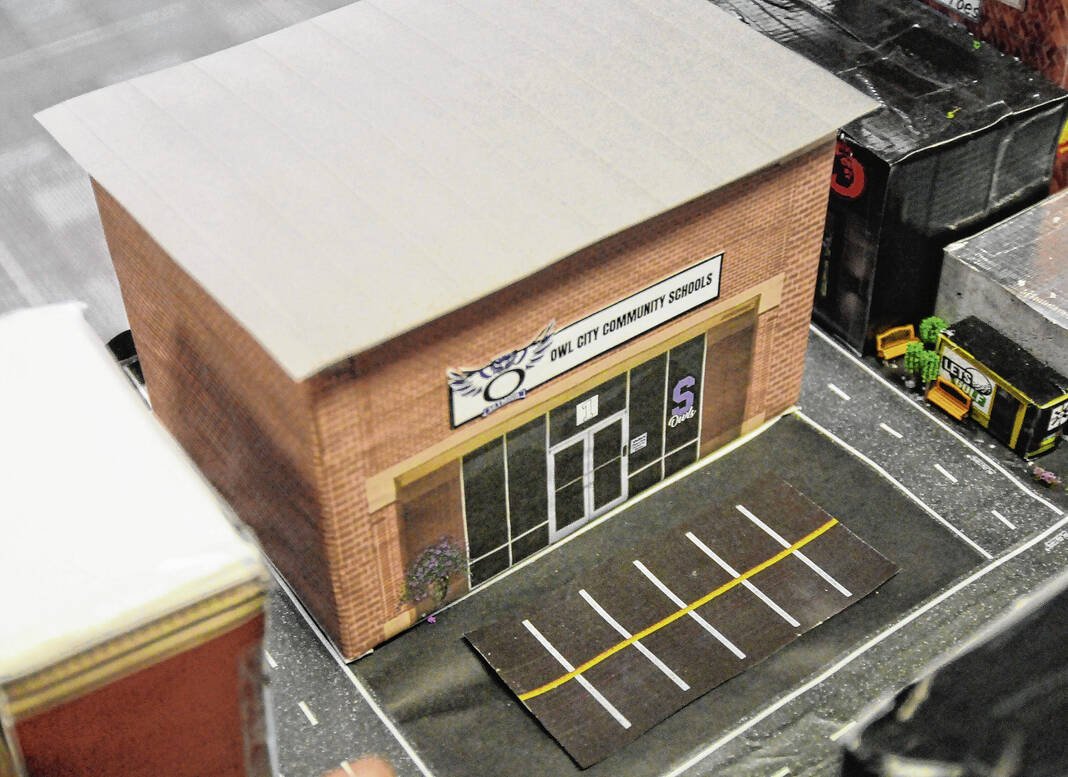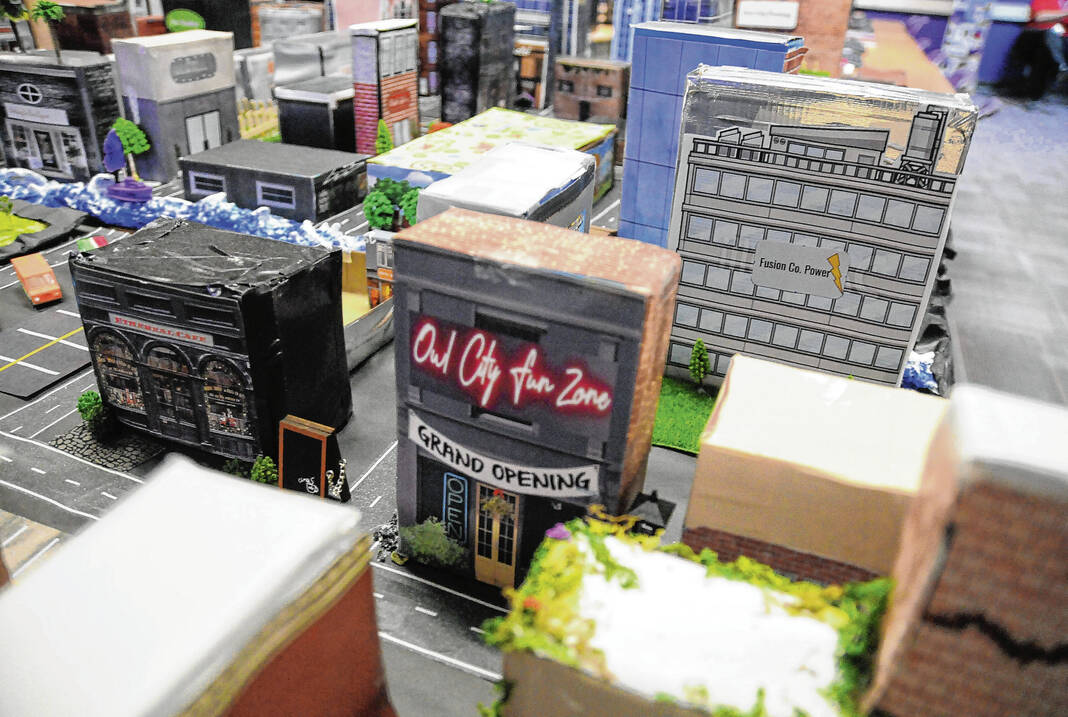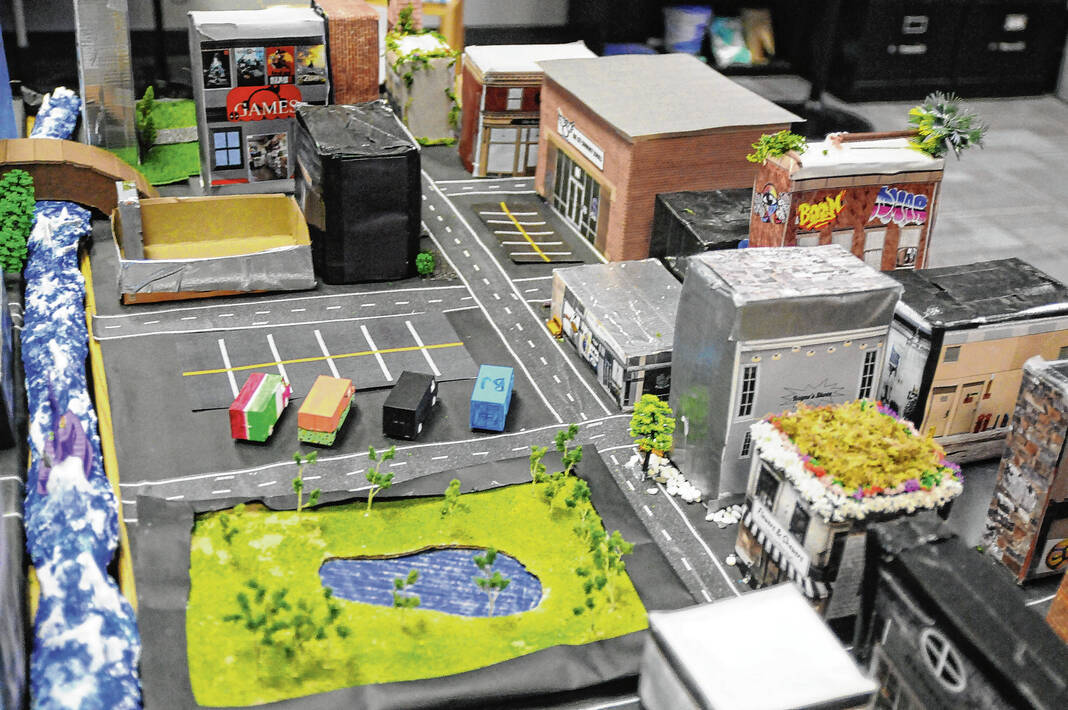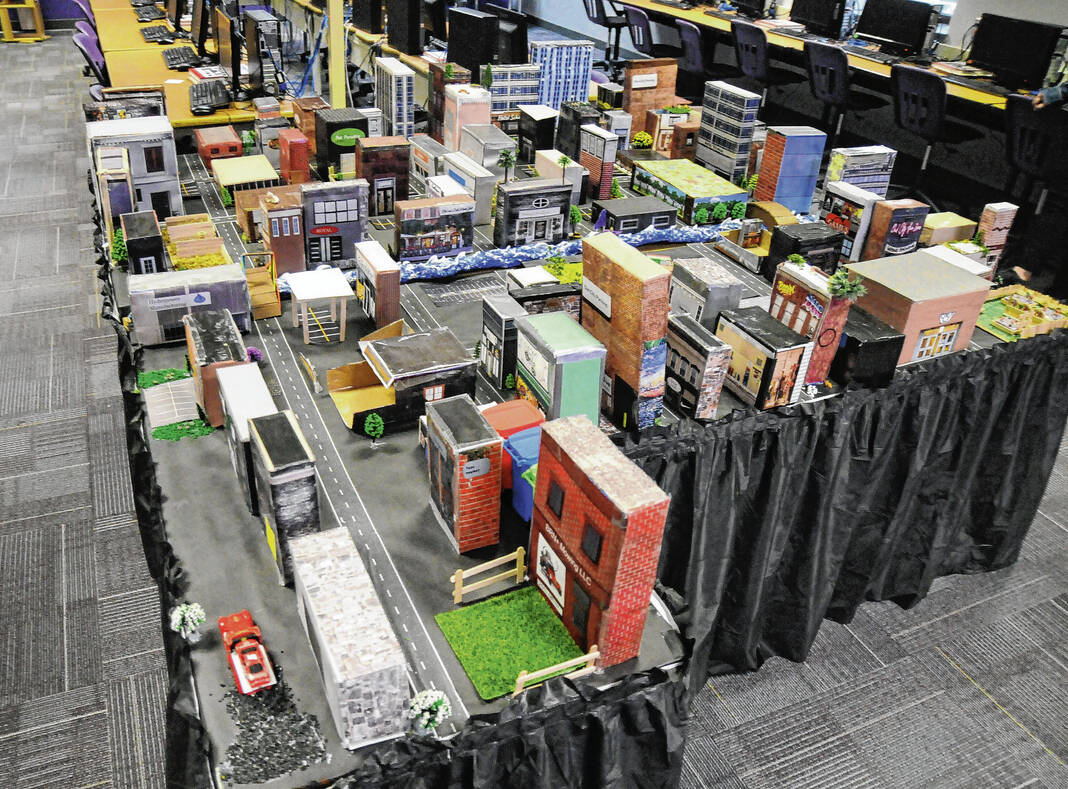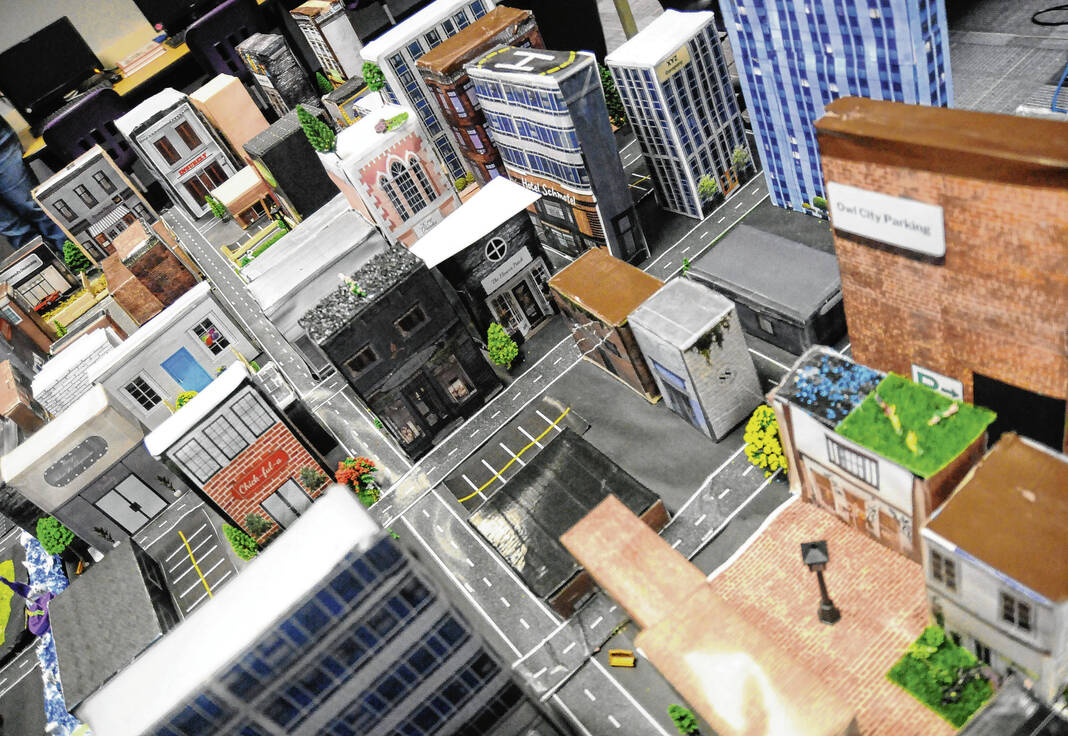Although the large display is set up in Robin Perry’s business classroom, Owl City was a project that involved several other Seymour High School departments, too.
Even the school custodians and principal, a school corporation administrator and a local business contributed.
After figuring out what business or service the city needed, each person used a cereal box, a cardboard box or a Pop-Tart box to create their building and then decorate it.
Bridges, parks, a canal, murals, turf, food trucks and trash cans also were made, and roads and turf were laid out.
It all came together to create a collaborative city project. That began in September and recently wrapped up.
“I thought it would be a nice way for me as a new teacher to get to know a lot of different folks and also a way to involve everybody because there are some students that may not remember Porter’s Five Forces, but they will remember their little business,” said Perry, who is in her first year as a business education teacher at SHS after being the business teacher at Brownstown Central High School.
She was inspired to do this project by fellow business educator Denise Leigh, a 2022 Pennsylvania Teacher of the Year finalist who had done a collaborative city project.
“Denise Leigh is an excellent business teacher, and I love to see what all she does because she does a lot of creative things. Business application, interactive, hands-on, I love it,” Perry said.
The project started in Perry’s principles of business management class. The core lessons about business included the needs versus wants in a city and what people think about while planning a city.
The students could work solo or with others in picking out their business. Then they had an ethics unit in which they decided how the business would give back to the community, and they created a SWOT analysis and an organizational chart and wrote job descriptions.
A math class figured out the scale of the city and determined the surface area to ensure all of the buildings would fit.
“They gave us some options, and we voted on the options to how we wanted to design our city, which one was most effective,” Perry said.
Then came the fun part of constructing the city and buildings, and Perry emailed other teachers and staff members about contributing.
Agriculture classes made the pocket parks, green spaces and rooftop gardens, art students made graffiti murals and a papier-mâché waterway, a construction class made bridges, a family and consumer sciences class made a boutique, a chemistry class made a crime lab, a biology class made a city park and a Project Lead the Way class made 3-D food trucks.
Plus, the Pep Club made a boat for the waterway, custodians added city trash cans, another business education class made two businesses and the assistant superintendent made a school.
Also part of the project, with the help of Principal Greg Prange, Perry’s students built vision towers. That allowed them to show the inside and outside of their business and list the products they sell, and they learned how to make a business plan. They also could earn badges for entrepreneurship, marketing and legal throughout the year.
“Each class designed their own badges that they awarded to the people, so each of the designs looks different,” Perry said.
Before Christmas, business law students acted as lawyers for Perry’s students as they came up with supplies needed for Christmas Fest, including decorations and lights.
“They wrote the supply contracts of all of the things we might need to get our city ready for a citywide festival like Christmas Fest,” Perry said.
A digital applications class contributed to Owl City by creating marketing and signage for the businesses, and a web design class created a website for various businesses.
Outside of the school, Perry received a $250 classroom education grant from the Community Foundation of Jackson County, and The Home Depot supplied turf.
Now that this year’s version of Owl City is completed, students in Perry’s class shared the role they played in the project.
Freshman Josh Hess built Tropical Sno because his father owns a chain of the shaved ice shop.
“It has been crazy,” he said of seeing the city develop. “I think it looks great. I feel like everyone has done really good at communicating and getting their places where they need to be.”
Freshman Alexander Bryant made Red Haven Sub Shop. He put his own spin on one of the places he likes to eat, Subway, by including his favorite color (red) and a safe place (haven) in the name.
“It was a whirlwind because a lot of people had to do certain things, and a lot of people had to make their own stuff,” he said of the yearlong collaborative effort. “It turned out pretty good. I liked learning other people’s skills of how they run stuff and make things.”
Classmate Sawyer Smith worked with a group to create Soara, a boating catering business near the canal.
“We were adding a canal, and they wanted something that would go up and down it,” he said. “It was really cool because none of us really spoke to each other before we all started doing business, and once we all came together, it was really good. We looked at a lot of the other businesses and just went off them a little bit and just kept improving ours. It was really cool, just really interesting to see what other people did.”
Bob and Dill’s Pickle Grill is one of the businesses along the canal. It was created by freshman Bradyn Riley.
“Soara was the main company, and they wanted a restaurant or a shop or something to go with it to bring in the tourists and take them there and show them,” he said.
During the school year, Riley said he liked going into Perry’s classroom to see what had been added.
“I liked seeing it overall, just the skyline of the small, little city come together, to see it grow into a bigger project where we can all work together and understand what it’s like to own a business and building a business and a metropolis,” he said.
Freshman Tyson Hillian said he recently became interested in cars, so he built Hillian’s Dealership for Owl City.
“I helped set up tables. It was cool to see three, four tables and it turn into this,” he said. “We added all of the extra little decorations throughout it, and I thought that made it look a lot better.”
Freshman Gerzain Gonzalez and sophomore Osvaldo Pablo were part of a group that developed WYOH Skateboards.
“It was pretty cool because we all had one image in mind, so we all just worked together really good to make it. It’s nice because we started from nothing, and now looking at all of it, it’s a lot,” Gonzalez said.
“It was a little bit hard because sometimes, we made mistakes and lost things, but it’s awesome because we started from nothing,” Pablo said.
Perry also liked seeing administrators get involved with Owl City.
Assistant Superintendent Lisa Ferguson created Owl City Community Schools.
“I wanted to contribute because the project is really about building community and making connections,” she said. “At Seymour schools, our mission is founded on building connections and relationships with all kinds of stakeholders. This project was that type of experience for not just the students in Mrs. Perry’s class but for students and teachers in a number of classes throughout the entire high school. Who wouldn’t want to be part of that?”
She said it also touched on fond memories from her early days of teaching.
“I taught third grade at Medora in the late ‘80s, and we would build out a replica of the town using boxes, paint and glue,” she said. “It was a big deal to the kids to get it just right. It was a great hands-on way to learn about and grow an appreciation for the place we live, go to school and work. I see a lot of this in Owl City.”
Contributing a school to Owl City was an easy choice for Ferguson.
“A school system in so many ways is the heart of any community,” she said. “As to the structure itself, Mrs. Perry provided some guidance on the structure and some materials to help you think about the design. The rest was left up to each participant’s creative vision for their contribution to Owl City.”
One of her favorite things about the project was the student participation and the pride in their contribution.
“Much like any community, we get back what we give,” Ferguson said. “This project was a great way to help our students understand the dynamics of a community and the important role each citizen plays in sustaining a thriving living and working environment.”
To view videos of the Owl City project throughout the school year, visit instagram.com/shs_owls_business.
Perry said the project will pick back up in the 2023-24 school year, so changes will be coming to Owl City. Other teachers already have discussed wanting to be part of it.
“You could tie just about anything into this, and we’ve got more to do next year,” she said. “If some kids want to take their business with them, they can. That will free up some spaces in the city for a new business to form. We’re going to add another table. There are a lot of needs we haven’t met yet. We don’t have a hospital. That’s a problem.”
Students will assess other opportunities and come up with their contributions to Owl City.
“It’s an educational artifact,” Perry said.

